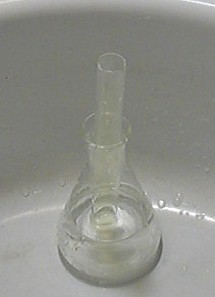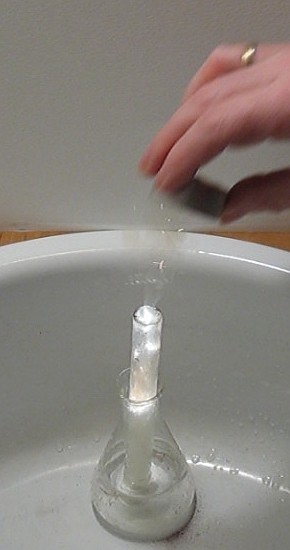


Chlorine initiated flash
Mixtures of oxidizers and aluminium powder, when ignited, give very bright white light. In pyrotechnics, such mixtures are used as flash powder. Especially, when the aluminium powder is very fine (1 .. 2 Ám, so-called German dark), the flash powder can be extremely fast-burning, giving intense white light. These flash-powders, however, can be somewhat difficult to ignite, depending on the oxidizer, used in the flash powder.
When a pinch of red phosphorus is added to such mixtures, then they become very easily ignited, even many cm above a flame, these powders can be ignited. This can be demonstrated very impressively, by keeping some of the mix above a little flame. Even more impressive is the demonstration, that such mixes can be ignited without any flame. Throwing some mix in chlorine gas also leads to ignition of the mix. The chlorine gas does not even need to be pure, even when only 30% of the air/chlorine mix consists of chlorine, the mix is ignited easily.
In this demonstration, a suitable mix of aluminium powder and potassium nitrate is treated with a tiny amount of phosphorus and that mix is ignited in some chlorine/air mix. This experiment is relatively safe to perform, but one should not scale up the quantities, mentioned in this page. When the quantities are not increased, and care is taken, not to inhale chlorine gas, then this cool experiment is really safe.
![]()
![]() Required
chemicals:
Required
chemicals:
-
chlorine gas (can be made from bleach and dilute hydrochloric acid, also from calcium hypochlorite and dilute hydrochloric acid)
- potassium nitrate
- aluminium powder (average particle size ~40 Ám or finer)
- red phosphorus
![]() Required
equipment:
Required
equipment:
-
test tube
-
something, such that the test tube can be kept vertically (e.g. an erlenmeyer, in which the test tube is positioned vertically)
![]() Safety:
Safety:
- Chlorine gas is very toxic, do not inhale the gas
- The smoke, produced in this experiment is not really toxic, but of course, one should avoid inhaling too much of the smoke
- Red phosphorus is very flammable
- Very fine aluminium powder is very flammable
-
 Do not scale up
the experiment and be careful with the mixed flash powder. The powder is
extremely fast burning and the fire is very hot.
Do not scale up
the experiment and be careful with the mixed flash powder. The powder is
extremely fast burning and the fire is very hot.
![]() Disposal:
Disposal:
- No toxic waste is produced. Any waste can be flushed down the drain and any solid waste can be wrapped in some thoroughly wetted tissue and disposed of with ordinary household waste.
![]()
Preparation of the flash mix
![]() Take
approximately 100 mg of potassium nitrate and crunch the solid to a fine powder.
Try to make it as fine as possible. The solid should be perfectly dry.
Take
approximately 100 mg of potassium nitrate and crunch the solid to a fine powder.
Try to make it as fine as possible. The solid should be perfectly dry.
![]() Add approximately 40 mg of fine aluminium powder and mix this
carefully through the powder of potassium nitrate. Mixing can be done by putting
both powders in a little dry beaker or on a dry piece of paper and carefully
swirling, such that the powders mix very well.
Add approximately 40 mg of fine aluminium powder and mix this
carefully through the powder of potassium nitrate. Mixing can be done by putting
both powders in a little dry beaker or on a dry piece of paper and carefully
swirling, such that the powders mix very well.
![]() Add approximately 20 mg of finely powdered red phosphorus and
mix this in the same way as the aluminium powder. As soon as the red phosphorus
is added, do not crunch anymore. Friction might ignite the mix!
Add approximately 20 mg of finely powdered red phosphorus and
mix this in the same way as the aluminium powder. As soon as the red phosphorus
is added, do not crunch anymore. Friction might ignite the mix!
![]() In a test tube, prepare some chlorine gas. A convenient way
of doing this is by adding some dilute hydrochloric acid to calcium
hypochlorite, some swimming pool chlorine or some bleach. The chlorine need not
be pure, a 50% concentration is suitable. Do this in a very well ventilated
room! Also do this at least one meter from the flash mix.
In a test tube, prepare some chlorine gas. A convenient way
of doing this is by adding some dilute hydrochloric acid to calcium
hypochlorite, some swimming pool chlorine or some bleach. The chlorine need not
be pure, a 50% concentration is suitable. Do this in a very well ventilated
room! Also do this at least one meter from the flash mix.
![]() Put the test tube with chlorine gas in a vertical position. A
convenient way of doing this is by using an erlenmeyer, with a thin layer of
water in it. The picture below shows how this can be done. Do not wait too long,
once the test tube with chlorine is positioned like this, otherwise the chlorine
diffuses out of the test tube. But one certainly can use the uncapped chlorine
in the test tube for 1 minute or so, diffusion is not that fast.
Put the test tube with chlorine gas in a vertical position. A
convenient way of doing this is by using an erlenmeyer, with a thin layer of
water in it. The picture below shows how this can be done. Do not wait too long,
once the test tube with chlorine is positioned like this, otherwise the chlorine
diffuses out of the test tube. But one certainly can use the uncapped chlorine
in the test tube for 1 minute or so, diffusion is not that fast.

![]()
Performing the experiment
![]() Once the
mix and chlorine gas are ready, the experiment is very easy to perform. Take a
metal miniature spatula and take a small amount (25 to 50 mg) from the
powder, and carefully throw it in the test tube with chlorine gas. This will
lead to an intense white flash and a roaring/hissing noise. Sometimes, the mix
ignites on the spatula already. Below, two pictures are shown from a flash,
happening on the spatula. The chlorine gas, diffusing out of the test tube,
ignites the mix. The left picture is the flash itself, the right picture is 33
ms after the flash.
Once the
mix and chlorine gas are ready, the experiment is very easy to perform. Take a
metal miniature spatula and take a small amount (25 to 50 mg) from the
powder, and carefully throw it in the test tube with chlorine gas. This will
lead to an intense white flash and a roaring/hissing noise. Sometimes, the mix
ignites on the spatula already. Below, two pictures are shown from a flash,
happening on the spatula. The chlorine gas, diffusing out of the test tube,
ignites the mix. The left picture is the flash itself, the right picture is 33
ms after the flash.



Another nice experiment is to take a small metal cup and put in a very tiny amount (10 mg or so) of the flash mix. If this flash mix is thrown into the test tube, then it first is spread out in the air, and the dispersed powder is entering the test tube, resulting in a spatially more distributed flash (actually, many small flashes).
Many times, the flashes are so bright that they are really blindening the eyes. Such flashes unfortunately cannot be captured by means of a camera, the entire image is totally overexposed and white.
A nice video is made of the flashing. A single test tube of chlorine is enough for making many flashes. For a video of the flashing experiment, click here. The size of the download is approximately 3 MByte. Download time depends on your internet connection.
![]()
Smoke rings
Another remarkable observation is the smoke pattern,
generated by this experiment. Everyone knows the classical smoke rings, drawn in
many
 cartoons,
such as shown in the popeye image. Making such rings usually is not easy at all, but in
this experiment, these rings are very easily formed, provided the flash occurs
inside the test tube and not above the test tube. The flash leads to formation
of smoke, but also leads to strong heating and expansion of the air. A fast
vertical ejection of smoke occurs, and while moving upwards, this almost always
transforms into a beautiful smoke ring. These rings are moving upwards very
quickly, but because of the frequent occurrence of them, it was not difficult at
all to capture some of them in a little video movie. Below, some smoke rings are
shown in pictures, and a nice video is shown of one of the smoke rings.
cartoons,
such as shown in the popeye image. Making such rings usually is not easy at all, but in
this experiment, these rings are very easily formed, provided the flash occurs
inside the test tube and not above the test tube. The flash leads to formation
of smoke, but also leads to strong heating and expansion of the air. A fast
vertical ejection of smoke occurs, and while moving upwards, this almost always
transforms into a beautiful smoke ring. These rings are moving upwards very
quickly, but because of the frequent occurrence of them, it was not difficult at
all to capture some of them in a little video movie. Below, some smoke rings are
shown in pictures, and a nice video is shown of one of the smoke rings.


















The smoke ring, shown above, is from a small flash, with a tiny amount of flash powder (probably less than 10 mg). Below, another more dense smoke ring is shown, which was quite impressive.






A slow-motion video (3 times slower than real time) of a smoke ring can be viewed here: slow motion smoke ring
![]()
Discussion of the results
The explanation of this experiment is quite simple. The basis of the experiment is formed by a mix of potassium nitrate and aluminium powder, a so-called flash mix. The main reaction is:
6KNO3 + 10Al → 3K2O + 3N2 + 5Al2O3
This reaction is extremely exothermic. The energy is emitted as intense heat and intense white light.
Igniting the mix, however, is somewhat difficult. Quite a strong flame is needed in order to get the mix burning. A very fine powder allows the reaction to proceed at a very high rate, and hence the term flash-powder is used. When a small amount of red phosphorus is added, then the mix is ignited much easier. The red phosphorus can be made to react with the potassium nitrate easily, and then the heat, produced in that reaction, is enough to ignite the Al/KNO3-mix.
The main reaction between red phosphorus and potassium nitrate is the following (also some P4O6 and lower phosphates (phosphites) are formed):
6KNO3 + 6P → 2K3PO4 + 3N2 + P4O10
Only a small amount of red phosphorus is needed to get the reaction with the aluminium going. This reaction provides sufficient heat to start the much more energetic reaction with the aluminium. So, the flash powder with some red phosphorus added, can easily be ignited, simply by keeping the powder above a small flame. It ignites at once.
The role of the chlorine gas is for igniting the mix. Chlorine is just initiating the reaction, once the reaction is going, no chlorine is needed anymore. In this experiment it is shown that red phosphorus ignites, when in contact with chlorine. This ignition provides sufficient heat to start the reaction between the red phosphorus and the potassium nitrate and that in turn provides sufficient heat to get the real flash reaction going.
It is surprising and cool to see the really bright flashes, without the need of an external ignition source.